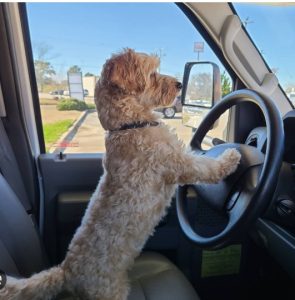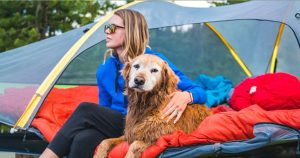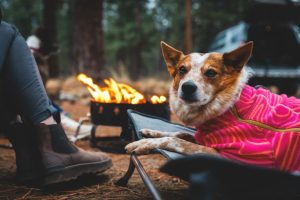Paws and Relax ~ Tips for Camping with Your Pet
(excerpts adopted from the DYRT Magazine)
Camping with pets is an incredible way to bond and explore nature together. However, ensuring both your and their comfort is essential, especially on those longer trips. Having lived in RV’s and other small spaces with my pets and been providing fun and safe pet homes for our park RVers, I’m going to share a few things I’ve gleaned.
Shaded areas in camp
If your campsite doesn’t have trees, try creating a shaded spot for your pet to relax. Portable canopies, pop-up tents, and tarps are great options. If none of those fit your camping lifestyle, try repositioning your car, van or RV to use the shade from the vehicle during the hot part of the day. Be sure to check with the campground for policies on these shelters.

A portable outdoor corral can keep your pet contained while still giving them freedom from the leash. However, these aren’t great for all pets, especially larger dogs or cats who can easily hop over the fence. Know your pet: if they want to get out, they will find a way. A retractable leash and harness combo could be a good alternative that will give them the freedom to move around without getting tangled up. Make sure to check with the campground in advance regarding their policy for pet corrals and portable canopies. Remember: if the ground is too hot to touch with the back of your hand, it’s too hot for pet paws. Grass is usually cool enough but soil or sand out in the sun can be scorching.
Protection from predators
The best tip in protecting your pet from a predator is to let them outside only when you are with them, especially at night, and to keep pet food and water either inside or empty. All wildlife should be respected for their role in the environment, and while healthy habitats need predators, you don’t want your beloved pets to be the prey. If camping in a natural scape, there is always a chance that space is also shared by other animals. Coyotes, snakes, racoons and hawks or owls can be of special concern to small dogs, especially at nightfall. Note: even though things in Texas are usually bigger than our neighbors, we’ve got some of the smallest predators ~ fire ants. They seem to prefer humans, but we do see them pester our pets that stumble upon their mounds.
Hydration
Pet hydration is crucial year-round, especially during outdoor adventures. Collapsible bowls are a great choice if you’re short on space but want a separate bowl exclusively for outdoor use. They pack small and are easy to set out when you get to camp. On hot days, dogs especially are prone to knocking over the water dish to lay in the puddle, leaving them without anything to drink. So, we also recommend investing in non-tipping bowls for camp and in your vehicle.
Portable pet beds/blankets
If you’re like my family, the dog is usually snuggled up in bed next to you at night. But during the day, your pup deserves their own spot to lounge. A light and portable pet bed gives them a designated space without creating too much extra bulk. Beyond being a cozy spot to nap, having their bed from home along for the trip can help comfort pets that tend to get anxious.
Keep clean
Keeping your RV, van or tent clean with a pet is a never-ending job. Pets pop in and out all day and shed in perpetuity, so hair and dirt are just part of the game. However, with a few tricks, you can keep things a bit tidier. Bring a good grooming brush and make it part of your daily routine. If you have electricity, a small vacuum can help keep the dirt and hair at bay, but a broom will also suffice. And for extra dirty or damp days, a container of baby wipes for soiled paws by the door can be helpful.
Calming tools
If you’ve got an anxious pet they may need a little extra TLC. Bring along familiar items from home, like blankets or toys to keep them at ease. If your dog gets nervous during storms, we recommend investing in a Thunder Shirt which can do wonders for some anxious dogs. Keep in mind, regular anxieties can be more amplified when a pet is somewhere new. When you opt to keep your pet home while you are away from the RV, consider using music or TV as white noise to keep them preoccupied. Keeping shades drawn or windows blocked is a good idea since squirrels, other pets with their humans or even blowing tree limbs can cause anxiety (sometimes barking) to some pets. In extreme cases you may resort to calming medications but make sure you dose correctly according to their size. This can be helpful if your pet has destructive behaviors when left alone. I’ve seen ripped shades and even scratched through door material.
Toys
Sure you’re in the great outdoors with squirrels to chase and birds to watch, but that doesn’t mean your furry friend can’t still get bored! Bring along some familiar and favorite toys to keep your pet busy when you’re not hitting the trails. You know what they like, so pack a couple of options and get them out as soon as you set up camp.

Pet safety 101 is don’t leave your pet in a hot car. But sometimes when traveling you can’t avoid leaving your pet in the vehicle. If you are plugged in and can run an A/C, that’s the best. However, the key is to keep the air moving in the vehicle when that’s not an option. Of course, you can keep the windows all open and fans blowing. Another method is to run a fan venting out and cracking a window while keeping everything else closed up. It may seem counter-intuitive, but the vent fan will pull air out of the vehicle and simultaneously pull in a steady stream of fresh, cool air through the cracked window. Make sure to park in the shade or cover windows to keep the sun out and install a temperature monitor that you can check remotely. This is also a great gadget to give peace of mind when you leave your pet in the cooled RV while you go out touring. If your AC or the parks electric fail, an RV can heat up like a metal box in the sun when it’s hot outside. Without a way to check on this or return if there is an issue, let your park host or someone you trust nearby know you have precious cargo in your RV that needs attention if the power or equipment goes down. Leave your mobile phone number with a neighbor or the park staff. A pet monitor can also be used.
Backup ID
Most folks keep a collar with a tag on their pet so they can be returned should they wander off and get lost. However, should they slip the loop or lose the tag, you’ll want another option to be reunited. GPS collars and AirTags are becoming popular with outdoor enthusiasts (remember, AirTags will only work where there is service or other iPhones). Of course, microchipping is the best way to ensure pets can be quickly returned if they wander off in unfamiliar surroundings.
Remember, too, that many parks are now requiring rabies vaccine proof for dogs and keeping a picture of the vet proof on your phone that can be shared with a park is the easiest way to fulfill that requirement.

At night, it’s easy to lose track of your pet. Reflective collars or vests can make spotting them easier. Consider an LED collar or blinking light for added nighttime visibility. They come in handy for night time walks around cities as well.
Bug protection
When sharing close quarters, you might want to consider what else besides dirt and hair your pet brings in after a long day playing outside. Nobody wants to wake up to flees or ticks in their space or on their body! Ensure your pet has the appropriate medical protection from pests, including heartworm medication. You never know what they might be getting into out in the wild.
Pet first-aid kit
Though injuries are rare, it’s good to be prepared so you can help your pet if needed. My typical pet kit includes: tweezers for pulling cactus spines, non-stick gauze and tender tape for wrapping sore or injured paws, antiseptic, Benydryl for the occasional bee sting, and pet nail clippers and file to clean up split nails. If you’re a big hiker consider investing in an emergency pet carrying harness. If something happens a few miles into the backcountry you want to be confident you can carry your dog out!
Emergency contacts and local vet info
Finally, before you head out (and potentially lose cell service), it’s wise to look up a few pet hospitals or veterinary clinics nearby. Consider keeping a list of emergency contacts pinned up and easy to find, so someone can take care of your pet if something should happen to you. At the end of the day you’ll always be happy to be prepared!
